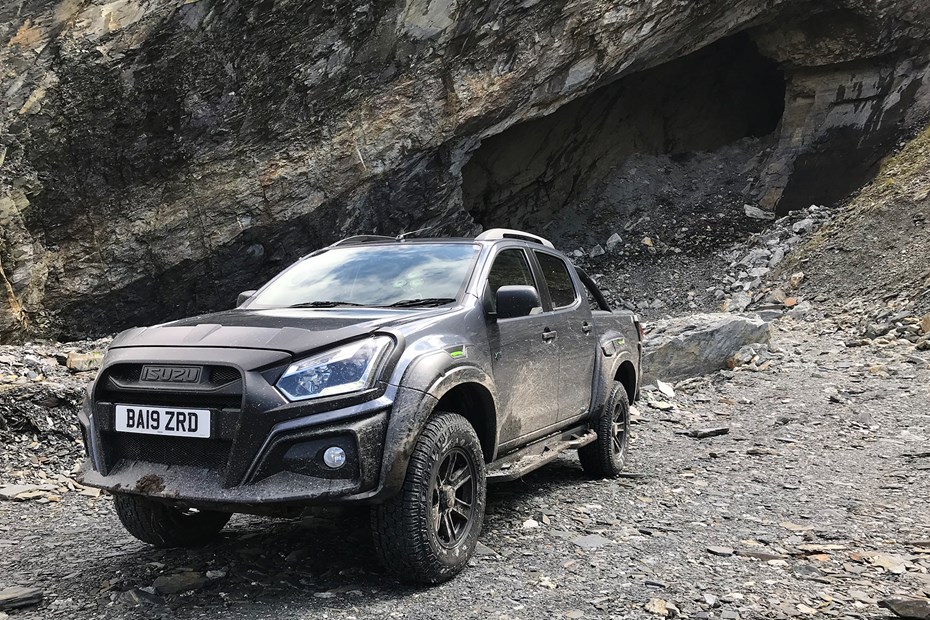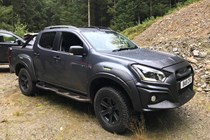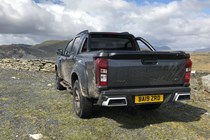Isuzu UK has something of a dilemma on its hands. Lifestyle pickup sales are booming, yet the D-Max remains absent from Waitrose carparks and pay-and-play sites, instead getting down to work with utility firms, local authorities and serious farmers. So much so that the most notable option package is called the Huntsman, and eschews stick on chrome and logos for drawers in which to lock weapons, tools, and the occasional trout.
Grabbing attention, if not volume sales, the Arctic Trucks AT35s have a lot of kerb appeal for drivers who grew up dreaming of their own Bigfoot – Tamiya or full-size – but they’re not exactly tuned for the school run or frequent commuting. At a time when Ford has added adaptive cruise control and active noise cancelling to the Ranger, and Mitsubishi’s got autonomous emergency braking on the L200, the D-Max is at the point where one-touch lane-changing indicators are still in the accessory catalogue…
Enter the D-Max XTR
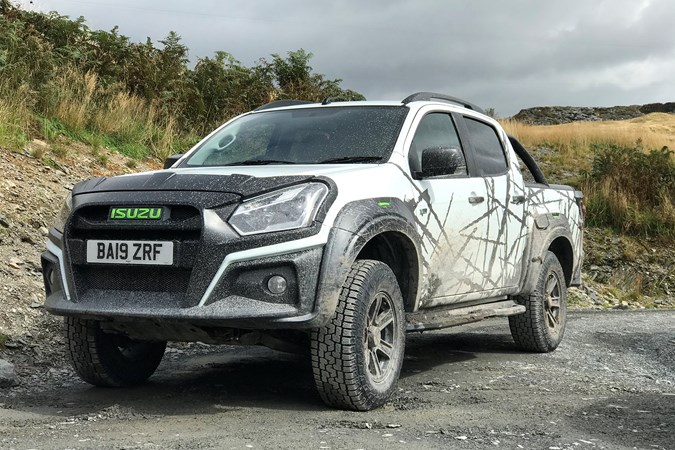
Everything about the D-Max XTR’s marketing suggests a new play for buyers of Wildtrack, Barbarian and Tekna-style luxury pickups, but it’s probably closer to the Ford Ranger Raptor in relevance – a wide, eye-catching bodykit with showroom appeal from lavishly trimmed seats and an eyecatching infotainment system, backed-up by serious off-road hardware. On paper it undercuts that Ford by over £6,000 before VAT; more like £16,000 when you consider the Ford isn’t a commercial vehicle. And that’s before benefit-in-kind and ‘actually carrying stuff’ is taken into account.
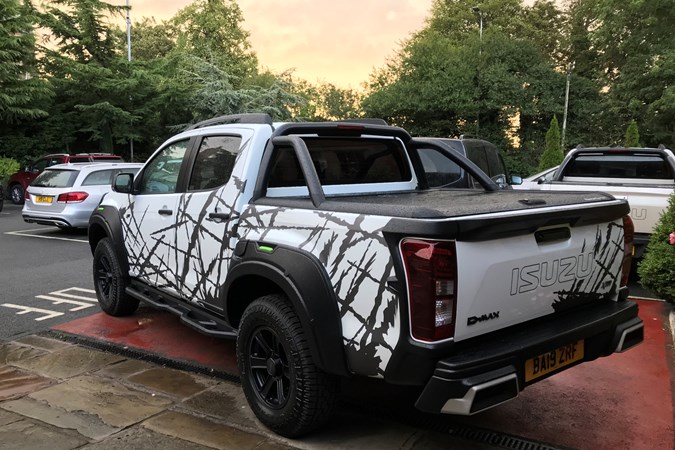
So the D-Max lands a couple of punches on the Raptor, but it’s not long before touches like manual air conditioning and seat adjustment give pause for buyers coming from £30,000+ SUVs and crossovers.
Being fair to Isuzu, the D-Max is one of the better pickups you can buy at the more basic end of the market, but the styling hasn’t changed much since 2012 and the interior remains quite utilitarian. That’s not an insult; Isuzu are the only pickup manufacturer to put the cupholders where you can see and reach them…
Under the bonnet is where the D-Max has evolved. A 164hp 1.9-litre engine no longer sounds so small when Ford’s dropped to 2.0 litres, and Mitsubishi only offers 150hp. Isuzu were one of the first pickup manufacturers to reduce capacity like this, and now other firms are following suit it’s clear why it had to happen. Reasonably economical, the D-Max manages to meet emissions standards without resorting to AdBlue, though it’s one of the lowest torque offerings you can get with just 360Nm
Selling the sizzle – the D-Max XTR’s showroom appeal
Given Isuzu’s lifestyle aspirations, making a pickup that once again focuses on off-road ability seems strange.
Aggressive black plastic arches and vibrant green suspension components, a dramatically reworked face and specially branded alloy wheels draw attention to the increased ride height; the XTR has 250mm of ground clearance with 32-inch Pirelli Scorpion tyres (a first for a production pickup) on 17-inch alloys.
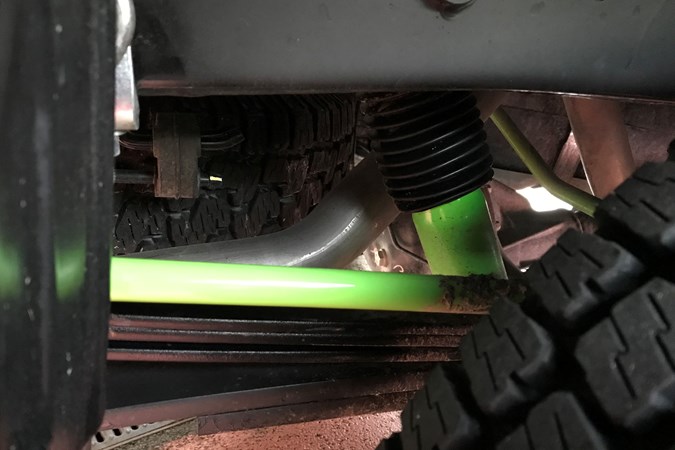
Wide-spaced spokes show off the green brake calipers, dampers and coils that are part of the Pedders suspension kit underpinning the XTR; with custom upper control arms to maintain on-road stability despite the lift, it’s basically the kind of kit that sells well in places like Australia (where the D-Max is also sold as the Holden Colorado – and is very popular).
Finishing off the XTR are black side steps in a new design, a tailgate spoiler and an under-rail load liner as standard.
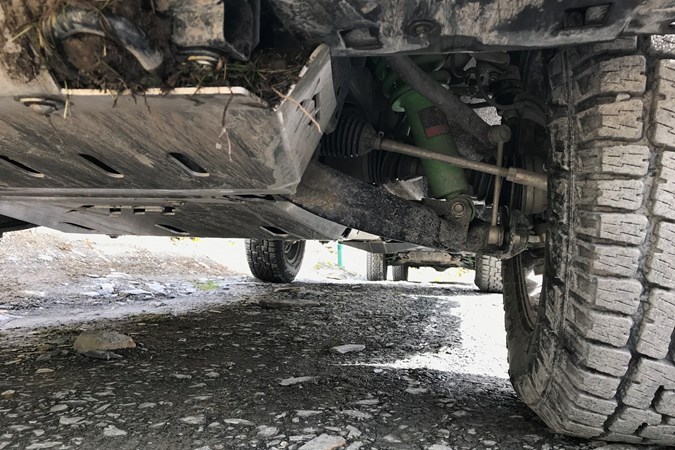
This Australian connection is important.
Not only is the antipodean nation still in love with Utes (even if those are now regular double-cab pickups, instead of pickup conversions of cars), it’s got one of the most draconian attitudes to car conversions and modification this side of Germany’s strict approval processes – plus, you really don’t want to alter your truck’s suspension then have it fail in the middle of the Outback.
The XTR’s alterations should last as long as the original Isuzu parts.
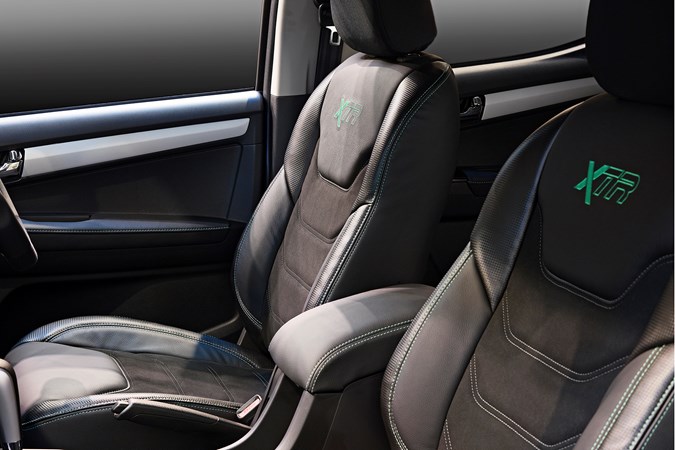
Inside, the manually-adjusted seats have leather and suede trim with bold XTR logos, and are generously padded – heating is also provided, albeit with a soft-touch button on the seat itself that helpfully lights up to tell your hip which of the three temperatures is selected.
Unusually for a pickup, the D-Max has an eight-speaker stereo with roof-mounted surround speakers, and as befits the ‘build-it yourself’ approach the relatively local, family-run dealers take, the infotainment is upgradeable, well-integrated aftermarket kit from Alpine or Panasonic. It’s not cheap, though – Navigation, CarPlay & DAB is £1,150 or £2,179 depending on screen size.
High performance D-Max?
Not quite as geared up for fast off-road driving as you might expect from its appearance, the XTR’s setup is more suited to slow-speed crawling and manoeuvrability, as the relatively narrow body and tight turning circle allow controlled climbs through obstacles and across paths.
Even so, thanks to a 1,975kg kerb weight this 164hp D-Max has 83hp per tonne, versus 85hp per tonne for the 213hp Ranger Raptor. They’re closer than you might expect.
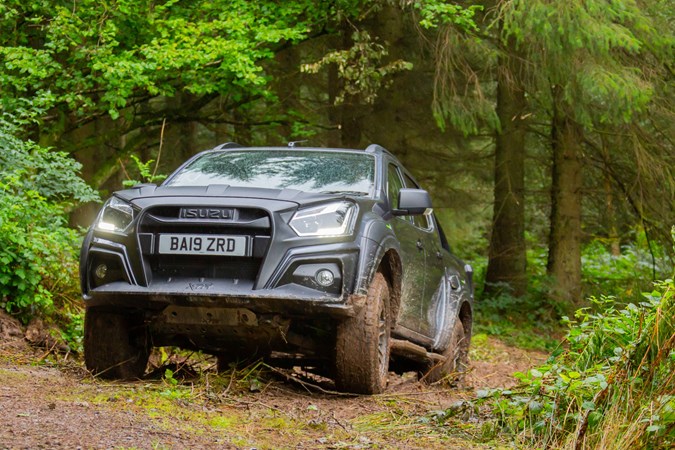
Having just 360Nm of torque is a different matter – especially compared to the Ford’s enormous 500Nm and 10-speed automatic combination. The XTR has the same six-speed manual or automatic as the regular D-Max, meaning relatively high revs at motorway speeds.
Still, unlike many lifestyle pickups the D-Max XTR qualifies for the same speed limits as a passenger car, meaning it can do 70mph on dual carriageways.
How’s the D-Max XTR off-road?
Rather than relying on Peterborough’s parkways and roundabouts, Isuzu’s newly-created forest track and the use of a popular Welsh quarry provided a chance to test the XTR off-road. It’s really good; anything you’re likely to encounter for work or leisure should be well within the XTR’s capabilities, and effective hill-descent control and grippy off-road tyres mean your off-road skills don’t need to be too honed to drive it.

A couple of obscured tree stumps helpfully demonstrated the effective protection provided by underbody guards and the XTR’s unique hexagon-patterned side steps.
Oddly enough, the bulky bodykit’s bonnet projections are very helpful for judging the position of the XTR on- and off-road – often, wider arches and bulges on the bodywork make it harder to judge and more stressful.
On road is where it counts for lifestyle pickup buyers
Despite the impressive off-road performance, the D-Max XTR is also remarkably refined on-road.
Even with the suspension lift, the XTR corners with relatively little bodyroll, and the chunky steering wheel is hooked-up to the wheels with minimal slack – those upgraded bushes and upper links do make a difference.
It’s easy to place this D-Max on the road ahead of a series of bends with confidence, and straight line stability is reassuring. New dampers and springs aren’t quite enough to transform the unashamedly traditional pickup ride quality of the XTR – you won’t mistake it for an SUV – but the sharp hops of an unladen bed have been muted and dialled-down to predictable undulations with little of the fidgety interruptions and jiggliness you’d expect.
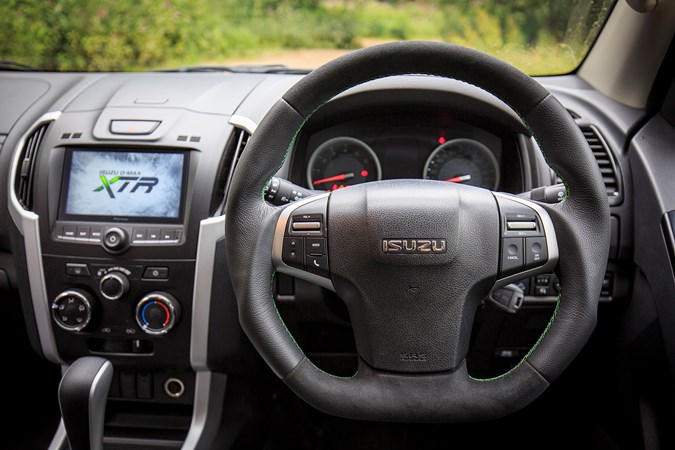
For a pickup, the D-Max XTR feels tied down and controlled at all times without feeling numb, and you’re aware the body is moving around more than any car would without being unsettled. Passengers in the back will feel more of it than the driver does, but we’d expect any bounciness to be reduced when towing or carrying a decent load.
Pressing on – the XTR’s looks and communicative steering do encourage it a bit – the 164hp engine struggles on hills and when powering out of bends. With the auto box, it’s also clear that once up to motorway speeds, there’s not much more on tap; the manual transmission keeps you more aware of what’s going on – not least by allowing the engine into the rather coarser upper end of the rev-range before you reach for the slightly vague, long-throw shift.
2018’s revisions to the regular D-Max improved ride and refinement markedly; the XTR takes that up a notch while also providing the kind of lift and suspension upgrades that more often result in a less stable attitude. For a jacked-up pickup, the XTR is a very effective, well thought out package.
Should I buy a D-Max XTR
That depends massively on why you want to buy it. If you’re after an aggressive-looking lifestyle pickup for family and work with not much off-road requirement, then no; as purposeful as it looks, it’s still well behind the likes of the Ranger Wildtrack or Navara N-Guard as a daily driver, and on comfort and convenience spec, it’s poor value compared with models such as the L200 Barbarian X or even a SsangYong Musso Saracen.
Conversely, if you need the 4x4 capability for work, Isuzu will happily equip a regular D-Max with most of the XTR’s functional upgrades, and there are accessories for arch, bumper and bonnet protection too. If you don’t mind fabric seats and are happy with more generic arch/bumper extensions, you could put together a comparably capable Yukon for about £6,000 less.
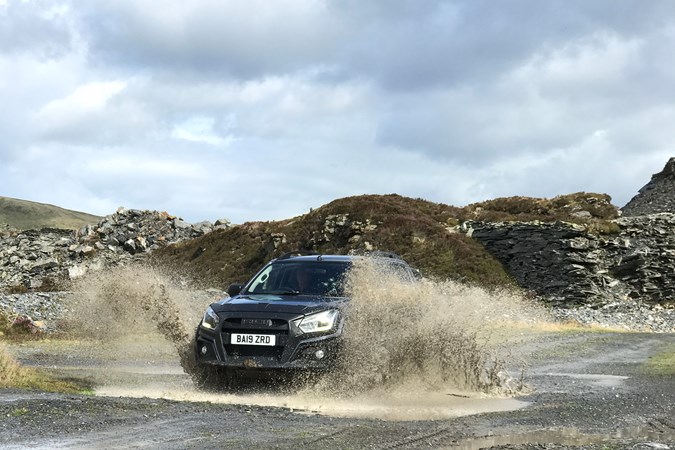
If you’ve fallen in love with the exaggerated desert-racer looks and lurid green highlights of this D-Max, though, and are just trying to justify it to yourself – or your family – the XTR is nicer to drive on road than a regular D-Max and far easier to live with than the extreme changes made by Arctic Trucks for the AT35.
Even as standard it’s got a similar power to weight ratio to the Ranger Raptor, and dealer-fitted upgrades can give it the 200hp, 400Nm grunt it needs to back up the aggressive façade – at which point it’ll not only be faster than the Ford, the advantages of a full payload, low kerb weight and commercial vehicle tax status all come together for significant savings.
If you’re considering buying all those aftermarket bits (including the steps and bodykit) for your brand-new pickup, bearing in mind modifying cars on lease or PCP is a bad idea, the XTR’s package is good value and effective. Like all these things though, it’s of limited relevance for buyers who spend most of their time on tarmac or mildly bumpy fields.
Also read:
>> New pickups coming soon – and recent launch round-up
>> The Parkers pickup group test – every double cab model compared
Just so you know, we may receive a commission or other compensation from the links on this website - read why you should trust us.


